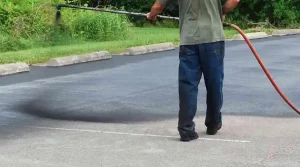Pavement repairs are critical for keeping your driveway looking nice and in excellent condition. The better the pavement maintenance, the longer it will endure, and the greater the return on your investment. You’ll also improve the look of your car and make driving much easier.
Let’s divide it by pavement type since various materials need different maintenance approaches.
Fixing up a gravel driveway
Gravel driveways are easy to construct but may be challenging to maintain. Ruts will form over time, and you may be tempted to pile more gravel on top. However, this is just a short-term remedy. So, what’s the honest answer?
Here are some pointers for maintaining your gravel driveway in excellent shape:
1. Compact and install like a pro
When constructing a gravel driveway, it is necessary to have a sturdy basis for the gravel. If you don’t, you’ll have difficulties in months. To do it correctly from the start, dig down about 12 inches and remove any roots or plant material. Break the soil using a plate crusher before adding the sub-base, sub-grade, and gravel layers.
2. Use stabilizing fabrics
Even with careful planning, your driveway may degrade. Consider utilizing a geotextile material before installing the subgrade layer in this scenario. This will provide a barrier between the surface and the subgrade, lowering the likelihood of potholes and ruts.
3. Try stabilizer panels
Stabilizer panels provide a barrier between the various levels of your driveway, aiding with gravel retention. The panels are honeycomb-like in structure, trapping gravel and absorbing vehicle stress to minimize ruts and potholes.
Mending a cracked asphalt pavement
Asphalt is popular because of its long life and ease of maintenance, but it must be repaired with the correct materials. Remove any weeds and thoroughly clean the gaps with a strong garden hose to repair cracks in your asphalt driveway. To prevent additional growth, use weed killer, then sand any gaps deeper than a quarter-inch. Use a patching compound after compacting the sand and allow it to dry. Finally, apply a sealer and let it dry.
Reviving your brick pavers
If you see any loose or broken brick pavers, it’s time to go to work. Mark the pavers first to be reinstalled in the right sequence and with the correct bricks. After removing the bricks and cleaning up the garbage, replace the sand. Make sure the sand is level before aligning the pavers using a screwdriver or similar even-sided item to ensure uniform spacing. Sand the gaps, then carefully pound the bricks into place with a hammer to remove any extra sand.
Fixing up a concrete driveway
Concrete driveways are long-lasting but may develop cracks and other problems with time. Here’s how to improve the appearance of your concrete driveway:
1. Clean and prep the area
First, remove debris from the affected area using a brush or a leaf blower. Use a wire brush or a pressure washer to clean more significant gaps of loose material.
2. Repair cracks and holes
Use concrete repair caulk or concrete crack filler to fill up minor cracks. You are smoothing the stuffing into the go with your finger or a putty knife. A tangible fixing substance is required for wider fractures or holes. Apply the compound as directed on the packaging, then level it evenly with a trowel. Allow the repair to dry and cure according to the manufacturer’s instructions.
3. Apply a concrete resurfacer.
A concrete resurfacer may give your worn-out concrete driveway a new appearance. Over the original concrete surface, a thin cement-based overlay is applied. Depending on the desired effect, mix the resurfacer according to the instructions and apply it using a squeegee, shovel, or brush. Allow it to dry and cure by the manufacturer’s instructions.
4. Seal the surface
After finishing the repairs and resurfacing, cover the surface with a concrete sealant to prevent additional degradation. Choose the best sealer for your needs and follow the application directions on the box.
Dealing with tree root damage
Tree roots may cause pavement cracking and upheavals. If tree roots are to fault, follow these steps:
1. Assess the situation
Determine which tree is causing the problem and whether it is worth saving. If the tree is healthy and essential to your landscape, consider working around it. If this is not the case, the tree may need to be removed to prevent further damage.
2. Cut offending roots
You must remove the problematic roots if you opt to retain the tree. Avoid damaging the tree by removing too many sources. If you need clarification on how to proceed, consult an arborist.
3. Repair the pavement
Following the removal of the roots, repair the damaged pavement by following the techniques mentioned above for the material of your driveway or walkway.
That’s all there is to it! You can handle almost any pavement repair problem with these tactics in your arsenal. Best wishes and speedy recovery! For more details, contact Jersey City Paving and Concrete right now.







